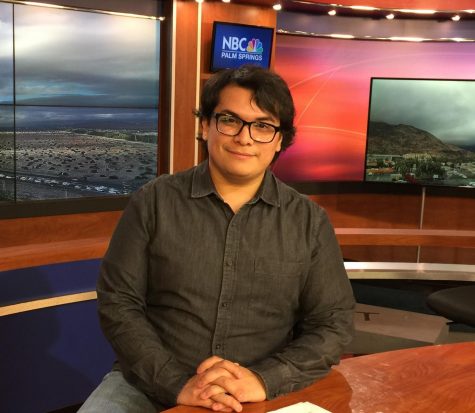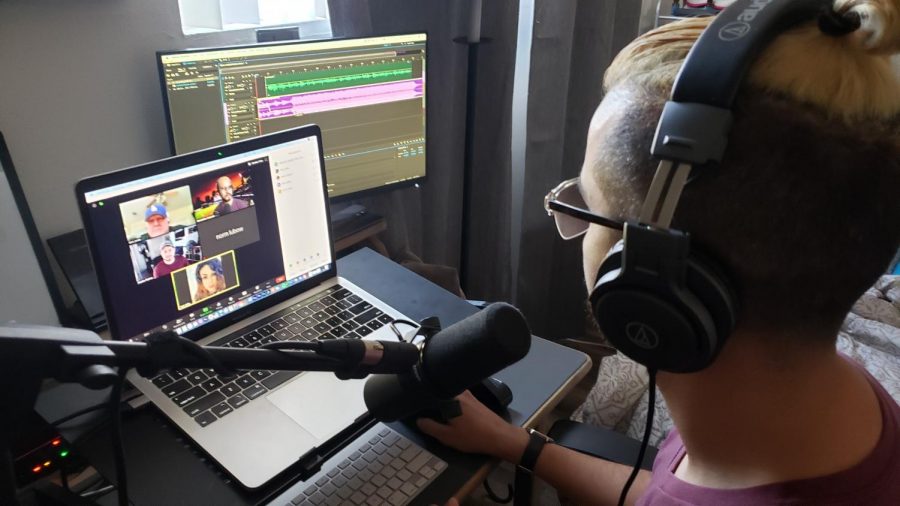Radio instructor teaches creative production from home
Photo courtesy of Alex Zatarain. Zatarain working from home teaching his radio production students via Zoom.
During the Spring 2020 semester, schools across the country closed their doors. Students were forced to stay at home and continue school online due to COVID-19.
This shutdown was a historic transition for the education world. Schools did not plan on teachers to teach their classes virtually rather than the traditional face-to-face concept. It was a switch no one was expecting. But it was necessary to help stop the spread of COVID-19 among students and staff.
Today, some schools are slowly reopening with cautionary measures to protect staff and students while others are still teaching either fully online or using Zoom. College of the Desert is virtual this fall semester. As for Spring 2021, the college recently announced that it’s likely 95% of the classes offered will continue in a virtual setting for the health and safety of students and staff. The college is working on a plan to bring some of the necessary lab classes back in a hybrid format.
Teaching over Zoom has been difficult for many. For those who are not familiar with online teaching, it’s a real struggle. COD offered faculty many online training sessions over the summer to make the online switch go smooth. For many instructors, the transition was a challenge but an opportunity to learn using new digital platforms.
Alexandro Zatarain, an adjunct instructor at COD who teaches the intermediate and advanced radio production classes, has a tremendous digital teaching handle. Zatarain works alongside COD’s mass media and radio production instructor, Toni Bakal. Zatarain also works as a lab technician with KCOD and The Chaparral newspaper.
Zatarain taught during the spring semester when COD shut its campus down due to the COVID-19 pandemic, and he knew that it would be an adjustment period for himself and his students.
“I knew from the get-go that I was going to have a lot of patience, not only for myself but with the students. It would be an adjustment for them, and I know many of our students don’t have access to technology, wifi and whatever they can’t from the campus at home. So, I knew that going into this situation back in March would take some time to adjust to everything going on and be a learning curve for everyone. But it was just a lot of patience.”
Since COD closed, students could not access the studios and radio equipment, including mics and recording and editing software, but that did not stop the faculty from getting creative and trying something new.
“Over the spring semester, we ordered several Snowball iCE USB microphones and rationed them out to students that needed them. We continue to provide them during this semester and have gotten students equipped with them. For editing software, there are free options online like Audacity or, if they have an Apple Product, Garageband. Not everyone uses them because some students pay for Adobe software, so they have Adobe Audition.”
Zoom teaching required needed changes to make everything work, especially for a lab class like radio production. Zatarain was up for the challenge and allowed his students to create shows and creative content that air on KCOD.
Zatarain said many students have little experience. “Of course, they gain the experience from being in the introduction to radio production, but once they produce their shows on their own over a semester, it can get a little more tedious. The biggest challenge is that I cannot sit there with them, help them out and listen to their work. Now I have them send me what they created, listen to it and provide feedback. I have sent them videos with tips since I can’t personally show them those tips since we’d have to be in a physical classroom, but I do my best to show them through other ways on how to create content.”
Zatarain said these past few months had been sort of a test to see what works best online versus what doesn’t, “I thought the students were very receptive, and I was very impressed with how they adjusted over the course of a few weeks, and they did very good jobs from home.
“Going into the summer semester, I kept the class pretty similar and condensed because you’re going from a 16 week semester to 8 weeks; I condensed it to make sure the students were going at a good pace to do over fall. I changed things up a little bit to better reflect participation in class, so just little things that we’ve adjusted to make the class a little more robust. Overall the goal was to make sure they could get their projects done while communicating with other students,” said Zatarain.
Schools will return someday to face-to-face classroom, but Zoom teaching has forced all instructors to adapt to their new environments, and because they had to adapt, teachers had to learn new techniques when it came to education.
Zatarain believes classroom teachings will return when it’s safe to do so and bring his new techniques along with him when that time comes. He believes in open dialogue and communication in his classes, even more so now that everyone is online.
“I am creating more dialogue. So what I’ve done in my Tuesday Zoom calls is to ask them questions connected to class like how they are doing and questions about pop culture because we’re in a media class. We talk about all these different things, and I try to relate to them,” said Zatarain.
Zatarain is a new instructor at COD. He is pleased with the diverse groups of students in his class. “I am a young professor; I’ve had students older than me. I try to connect with my students as best as I can to create open conversations. I try to make them comfortable and encourage them to talk in the classroom setting. Then we move forward from there, and we talk about the reading and creating discussions from the lessons.
Zatarain added, “On Canvas, I have discussions posted where the students share details from their readings due every Thursday. The discussions can be about the book, their production, and many other things that have to do with the class. I think communication has gotten a lot stronger between myself and my students over the last few semesters, and I think implementing it the way I have this semester has helped because it allows the students to open up more and think more critically about what they are doing.”
The introduction, intermediate and advanced radio production courses are offered every semester and summer at COD. The course numbers are RTV007, RTV007A and RTV007B. Students learn all about the radio industry and create shows for KCOD radio. You can hear KCOD on iTunes, the KCOD app or at www.kcodcoachellafm.com.

Omar Romero is the online editor, staff reporter for The Chaparral. His career goal is to become either a sports radio host, sports commentator on television...

